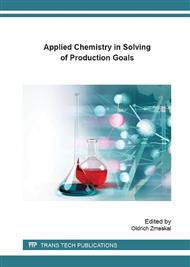[1]
M.C. Linder , M. Hazegh-Azam, Copper biochemistry and molecular biology, Am J Clin Nutr. 63 (1996) 797S-811S.
Google Scholar
[2]
E. Salinas, M. Elorza de Orellano , I. Rezza L. Martinez , E. Marchesvky, M. Sanz de Tosetti, Removal of cadmium and lead from dilute aqueous solutions by Rhodotorula rubra, Bioresource Technology 72 (2000) 107-112.
DOI: 10.1016/s0960-8524(99)00111-x
Google Scholar
[3]
A. Kapoor, , T. Viraraghavan, Fungal biosorption: an alternative treatment option for heavy metal bearing wastewaters, A review. Bioresource Technology. 53 (1995) 195-206.
DOI: 10.1016/0960-8524(95)00072-m
Google Scholar
[4]
C. Cojocaru, M. Diaconu, I. Cretescu I., J. Savič, V. Vasič, Biosorption of copper(II) ions from aqua solutions using dried yeast biomass, Colloids and Surfaces A: Physicochem. Engin. Asp. 335 (2009) 181-188.
DOI: 10.1016/j.colsurfa.2008.11.003
Google Scholar
[5]
M.T. Vidal, M. Poblet, , M. Constanti, and Bordons, A., Inhibitory effect of copper and dichlofluanid on Oenococcus oeni and malolactic fermentation, Am. J. Enol. Viticult. 52 (2001) 223–229.
DOI: 10.5344/ajev.2001.52.3.223
Google Scholar
[6]
S.V. Avery, , N.G. Howlett, S. Radice, Copper toxicity towards Saccharomyces cerevisiae : Dependence on plasma membrane fatty acid composition. Appl. Environ. Microbiol. 62 (1996) 3960–3966.
DOI: 10.1128/aem.62.11.3960-3966.1996
Google Scholar
[7]
A. Presta, M. J. Stillraan, Incorporation of copper into the yeast Saccharomyces cerevisiae. identification of Cu(I)-Metallothionein in intact yeast cells. J. Inorg. Biochem. 66 (1997) 231–240.
DOI: 10.1016/s0162-0134(96)00216-4
Google Scholar
[8]
M. Azenha, M.T. Vasconcelos, P. Moradas-Ferreira, The influence of Cu concentration on ethanolic fermentation by Saccharomyces cerevisiae . J. Biosci. Bioengin. 90 (2000) 163–167.
DOI: 10.1016/s1389-1723(00)80104-8
Google Scholar
[9]
G. Dönmez, Z. Aksu, Bioaccumulation of copper (II) and nickel (II) by the nonadapted and adapted growing Candida sp. Water Res. 35 (2001)1425-1434.
DOI: 10.1016/s0043-1354(00)00394-8
Google Scholar
[10]
P. Davoli, R.W.S. Weber, Carotenoid pigments from the red mirror yeast, Sporobolomyces roseus. Mycologist. 16 (2002) 102-108.
DOI: 10.1017/s0269915x02001027
Google Scholar
[11]
E. Breierová, M. Čertík, A. Kovárová, T. Gregor, Biosorption of nickel by yeasts in an osmotically unsuitable environment. Zeitsch. Naturforschung C J. Biosc., 63 (2008) 873-878.
DOI: 10.1515/znc-2008-11-1215
Google Scholar
[12]
A.R. Sergio, M.D. Paiva, R. M. Russell, MD ß-Carotene and Other Carotenoids as Antioxidants J. Am. Coll. Nutr., 18 (1999) 426–433.
Google Scholar
[13]
E. Breierova, E. Stratilova, J. Šajbidor, Production of Extracellular Polymers by Yeast-like Genera Dipodascus and Dipodascopsis under NaCl Stress Folia Microbiol. 41 (1996) 257-263.
DOI: 10.1007/bf02814627
Google Scholar
[14]
E. Stratilová, E. Breierová, R. Vadkertiová, E. Machová, A. Malovíková, E. Sláviková, The adaptability of the methylotrophic yeast Candida boidinii on media containing pectic substances. Canad.J. Microbiol. 44 (1996) 116-120.
DOI: 10.1139/w97-142
Google Scholar
[15]
Dubois M., Gilles K.A., Hamilton J.K., Rebers P.A., Smith F., Colorimetric method for determination of sugars and related substances. Analyt. Chem., 28 (1956) 350-356.
DOI: 10.1021/ac60111a017
Google Scholar
[16]
Lowry O.H., Rosebrough N.J., Farrand A.J., Randall R.J., Protein measurement. J. Biol. Chem., 193 (1951) 265-275.
Google Scholar
[17]
E. Breierová, I. Vajcziková, V. Sasinková, E. Stratilová, M. Fišera, T. Gregor, J. Šajbidor, Biosorption of cadmium ions by different yeast species. Zeitsch. Naturforschung C J. Biosc., 57 (2002) 634-639.
DOI: 10.1515/znc-2002-7-815
Google Scholar
[18]
G.I. Frengova, D.M. Beshkova Carotenoids from Rhodotorula and Phaffia: yeasts of biotechnological importance, J. Ind. Microbiol. Biotechnol 36 (2009) 163-180.
DOI: 10.1007/s10295-008-0492-9
Google Scholar
[19]
I.R. Maldonade, D.B. Rodriguez-Amaya, A. R:P. ScampariniCarotenoids of yeasts isolated from the Brazilian ecosystem. Food Chemistry, 107 (2008) 145-150.
DOI: 10.1016/j.foodchem.2007.07.075
Google Scholar
[20]
S. Sperstad , B.F. Lutnaes , S.K. Stormo, S. Liaaen-Jensen, B. Landfald, Torularhodin and torulene are the major contributors to the carotenoid pool of marine Rhodosporidium babjevae (Golubev), J. Ind. Microbiol. Biotechnol. 33 (2006) 269-273.
DOI: 10.1007/s10295-005-0065-0
Google Scholar


